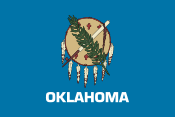Trail of Tears

The Trail of Tears was the forced relocation of Native Americans from their homelands to Indian Territory (present day Oklahoma) in the Western United States. The phrase originated from a description of the removal of the Choctaw Nation in 1831.[1] Many Native Americans suffered from exposure, disease, and starvation while en route to their destinations, and many died, including, for example, 4,000 of the 15,000 relocated Cherokee.[2] Thousands of enslaved and free African-Americans (as slaves accompanying their Native American slaveowners and as former runaway slaves that were assisted by, assimilated by, or married to members of the tribes) accompanied the removed nations on the Trail of Tears.[3]
In 1830, the Cherokee, Chickasaw, Choctaw, Muscogee (Creek), and Seminole (sometimes collectively referred to as the Five Civilized Tribes) were living as autonomous nations in what would be called the American Deep South. The process of cultural transformation (proposed by George Washington and Henry Knox) was gaining momentum, especially among the Cherokee and Choctaw.[4] Indian removal was first proposed by Thomas Jefferson. Andrew Jackson was the first U.S. President to implement removal with the passage of the Indian Removal Act of 1830. In 1831 the Choctaw were the first to be removed, and they became the model for all other removals. After the Choctaw, the Seminole were removed in 1832, the Creek in 1834, then the Chickasaw in 1837, and finally the Cherokee in 1838.
Contents |
Choctaw voluntary removal

The Choctaw nation was in what are now the U.S. states of Alabama, Mississippi, and Louisiana. After a series of treaties starting in 1801, the Choctaw nation was reduced to 11,000,000 acres (45,000 km2). The Treaty of Dancing Rabbit Creek ceded the remaining country to the United States and was ratified in early 1831. The removals were only agreed to after a provision in the Treaty of Dancing Rabbit Creek allowed some Choctaw to remain. George W. Harkins would write to the American people before the removals were to commence.
| “ | It is with considerable diffidence that I attempt to address the American people, knowing and feeling sensibly my incompetency; and believing that your highly and well improved minds would not be well entertained by the address of a Choctaw. But having determined to emigrate west of the Mississippi river this fall, I have thought proper in bidding you farewell to make a few remarks expressive of my views, and the feelings that actuate me on the subject of our removal ... We as Choctaws rather chose to suffer and be free, than live under the degrading influence of laws, which our voice could not be heard in their formation.
. |
” |
|
—-George W. Harkins, George W. Harkins to the American People [6] |
||
Secretary of War Lewis Cass appointed George Gaines to manage the removals. Gaines decided to remove Choctaws in three phases starting in 1831 and ending in 1833. The first was to begin on November 1, 1831 with groups meeting at Memphis and Vicksburg. A harsh winter would batter the emigrants with flash floods, sleet, and snow. Initially the Choctaws were to be transported by wagon but floods halted them. With food running out, the residents of Vicksburg and Memphis were concerned. Five steamboats (the Walter Scott, the Brandywine, the Reindeer, the Talma, and the Cleopatra) would ferry Choctaws to their river-based destinations. The Memphis group traveled up the Arkansas for about 60 miles (97 km) to Arkansas Post. There the temperature stayed below freezing for almost a week with the rivers clogged with ice there would be no travel for weeks. Food rationing consisted of a handful of boiled corn, one turnip, and two cups of heated water per day. Forty government wagons were sent to Arkansas Post to transport them to Little Rock. When they reached Little Rock, Choctaw chief (thought to be Thomas Harkins or Nitikechi) quoted to the Arkansas Gazette that the removal was a "trail of tears and death."[7] The Vicksburg group was led by an incompetent guide and was lost in the Lake Providence swamps.

Alexis de Tocqueville, the French philosopher, witnessed the Choctaw removals while in Memphis, Tennessee in 1831,
| “ | In the whole scene there was an air of ruin and destruction, something which betrayed a final and irrevocable adieu; one couldn't watch without feeling one's heart wrung. The Indians were tranquil, but sombre and taciturn. There was one who could speak English and of whom I asked why the Chactas were leaving their country. "To be free," he answered, could never get any other reason out of him. We ... watch the expulsion ... of one of the most celebrated and ancient American peoples. | ” |
|
—- Alexis de Tocqueville, Democracy in America[8] |
||
Nearly 15,000 Choctaws made the move to what would be called Indian Territory and then later Oklahoma.[9] About 2,500–6,000 died along the trail of tears. Approximately 5,000–6,000 Choctaws remained in Mississippi in 1831 after the initial removal efforts.[10][11] The Choctaws who chose to remain in newly formed Mississippi were subject to legal conflict, harassment, and intimidation. The Choctaws "have had our habitations torn down and burned, our fences destroyed, cattle turned into our fields and we ourselves have been scourged, manacled, fettered and otherwise personally abused, until by such treatment some of our best men have died."[11] The Choctaws in Mississippi were later be formed as the Mississippi Band of Choctaw Indians and the removed Choctaws be called the Choctaw Nation of Oklahoma.
Seminole resistance
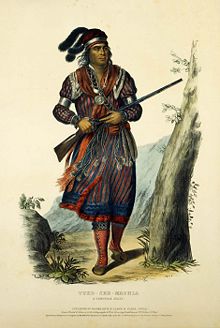
The US acquired Florida from Spain via the Adams-Onís Treaty and took possession in 1821. In 1832 the Seminoles were called to a meeting at Payne's Landing on the Oklawaha River. The treaty negotiated called for the Seminoles to move west, if the land were found to be suitable. They were to be settled on the Creek reservation and become part of the Creek tribe. The Seminole Indians who originated from the Creek were considered deserters by the Creek, and the Seminole did not wish to move west to where they were certain that they would meet certain death for leaving the main band Creek Indians. The delegation of seven chiefs who were to inspect the new reservation did not leave Florida until October 1832. After touring the area for several months and conferring with the Creeks who had already been settled there, the seven chiefs signed on March 28, 1833 a statement that the new land was acceptable. Upon their return to Florida, however, most of the chiefs renounced the statement, claiming that they had not signed it, or that they had been forced to sign it, and in any case, that they did not have the power to decide for all the tribes and bands that resided on the reservation. The villages in the area of the Apalachicola River were more easily persuaded, however, and went west in 1834.[12] On December 28, 1835 a group of Seminoles and escaped slaves ambushed a U.S. Army company attempting to forcibly remove the Seminole. Out of 110 army troops only 3 survived, and with that the Second Seminole War had begun.
As the realization that the Seminoles would resist relocation sank in, Florida began preparing for war. The St. Augustine Militia asked the War Department for the loan of 500 muskets. Five hundred volunteers were mobilized under Brig. Gen. Richard K. Call. Indian war parties raided farms and settlements, and families fled to forts, large towns, or out of the territory altogether. A war party led by Osceola captured a Florida militia supply train, killing eight of its guards and wounding six others. Most of the goods taken were recovered by the militia in another fight a few days later. Sugar plantations along the Atlantic coast south of St. Augustine were destroyed, with many of the slaves on the plantations joining the Seminoles.[13]
Other warchiefs such as Halleck Tustenuggee, Jumper, and Black Seminoles Abraham and John Horse continued the Seminole resistance against the army. The war ended, after a full decade of fighting, in 1842. The U.S. government is estimated to have spent about $20,000,000 on the war, at the time an astronomical sum. Many Indians were forcibly exiled to Creek lands west of the Mississippi; others retreated into the Everglades. In the end, the government gave up trying to subjugate the Seminole in their Everglades redoubts and left less than 100 Seminoles in peace.[14]
Creek dissolution
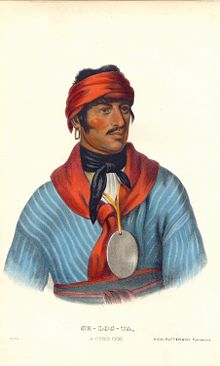
After the War of 1812, some Muscogee leaders such as William McIntosh signed treaties that ceded more land to Georgia. The 1814 signing of the Treaty of Fort Jackson signaled the end for the Creek Nation and for all Indians in the South.[16] Friendly Creek leaders, like Selocta and Big Warrior, addressed Sharp Knife (the Indian nickname for Andrew Jackson) and reminded him that they keep the peace. Nevertheless, Jackson retorted that they did not "cut (Tecumseh's) throat" when they had the chance, so they must now cede Creek lands. Jackson also ignored Article 9 of the Treaty of Ghent that restored sovereignty to Indians and their nations.
| “ | Jackson opened this first peace session by faintly acknowledging the help of the friendly Creeks. That done, he turned to the Red Sticks and admonished them for listening to evil counsel. For their crime, he said, the entire Creek Nation must pay. He demanded the equivalent of all expenses incurred by the United States in prosecuting the war, which by his calculation came to 23,000,000 acres (93,000 km2) of land. | ” |
|
—- Robert V. Remini, Andrew Jackson[17] |
||
Eventually, the Creek Confederacy enacted a law that made further land cessions a capital offense. Nevertheless, on February 12, 1825, McIntosh and other chiefs signed the Treaty of Indian Springs, which gave up most of the remaining Creek lands in Georgia. [1] After the U.S. Senate ratified the treaty, McIntosh was assassinated on May 13, 1825, by Creeks led by Menawa.
The Creek National Council, led by Opothle Yohola, protested to the United States that the Treaty of Indian Springs was fraudulent. President John Quincy Adams was sympathetic, and eventually the treaty was nullified in a new agreement, the Treaty of Washington (1826). [2] Writes historian R. Douglas Hurt: "The Creeks had accomplished what no Indian nation had ever done or would do again — achieve the annulment of a ratified treaty."[18] However, Governor Troup of Georgia ignored the new treaty and began to forcibly remove the Indians under the terms of the earlier treaty. At first, President Adams attempted to intervene with federal troops, but Troup called out the militia, and Adams, fearful of a civil war, conceded. As he explained to his intimates, "The Indians are not worth going to war over."
Although the Creeks had been forced from Georgia, with many Lower Creeks moving to the Indian Territory, there were still about 20,000 Upper Creeks living in Alabama. However, the state moved to abolish tribal governments and extend state laws over the Creeks. Opothle Yohola appealed to the administration of President Andrew Jackson for protection from Alabama; when none was forthcoming, the Treaty of Cusseta was signed on March 24, 1832, which divided up Creek lands into individual allotments. [3] Creeks could either sell their allotments and received funds to remove to the west, or stay in Alabama and submit to state laws. Land speculators and squatters began to defraud Creeks out of their allotments, and violence broke out, leading to the so-called "Creek War of 1836." Secretary of War Lewis Cass dispatched General Winfield Scott to end the violence by forcibly removing the Creeks to the Indian Territory west of the Mississippi River.
Chickasaw monetary removal
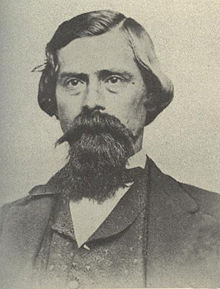
Unlike other tribes who exchanged land grants, the Chickasaw received financial compensation from the United States for their lands east of the Mississippi River. In 1836 the Chickasaws had reached an agreement that purchased land from the previously removed Choctaws after a bitter five-year debate. They paid the Choctaws $530,000 for the western most part Choctaw land. The first group of Chickasaws moved in 1837 was led by John M. Millard. The Chickasaws gathered at Memphis, Tennessee on July 4, 1837, with all of their assets--belongings, livestock, and slaves. Once across the Mississippi River they followed routes previously established by Choctaws and Creeks. Once in Indian Territory the Chickasaws merged with the Choctaw nation. After several decades of mistrust, they regained nationhood and established a Chickasaw nation.
Cherokee forced relocation
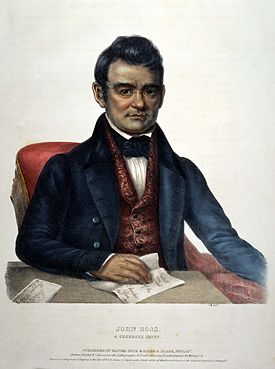
In 1838, the Cherokee Nation was removed from their lands in Georgia to the Indian Territory (present day Oklahoma) in the Western United States, which resulted in the deaths of approximately 4,000 Cherokees.[19] In the Cherokee language, the event is called Nunna daul Isunyi—“the Trail Where They Cried”. The Cherokee Trail of Tears resulted from the enforcement of the Treaty of New Echota, an agreement signed under the provisions of the Indian Removal Act of 1830 which exchanged Native American land in the East for lands west of the Mississippi River, but which was never accepted by the elected tribal leadership or a majority of the Cherokee people.
Tensions between Georgia and the Cherokee Nation were brought to a crisis by the discovery of gold near Dahlonega, Georgia, in 1829, resulting in the Georgia Gold Rush, the first gold rush in U.S. history. Hopeful gold speculators began trespassing on Cherokee lands, and pressure began to mount on the Georgia government to fulfill the promises of the Compact of 1802.
When Georgia moved to extend state laws over Cherokee tribal lands in 1830, the matter went to the U.S. Supreme Court. In Cherokee Nation v. Georgia (1831), the Marshall court ruled that the Cherokees were not a sovereign and independent nation, and therefore refused to hear the case. However, in Worcester v. State of Georgia (1832), the Court ruled that Georgia could not impose laws in Cherokee territory, since only the national government — not state governments — had authority in Indian affairs.
| “ | John Marshall has made his decision; now let him enforce it! | ” |
|
—-Andrew Jackson |
||
Jackson probably never said this, but he was fully committed to the policy. He had no desire to use the power of the national government to protect the Cherokees from Georgia, since he was already entangled with states’ rights issues in what became known as the nullification crisis. With the Indian Removal Act of 1830, the U.S. Congress had given Jackson authority to negotiate removal treaties, exchanging Indian land in the East for land west of the Mississippi River. Jackson used the dispute with Georgia to put pressure on the Cherokees to sign a removal treaty.[20]
Nevertheless, the treaty, passed by Congress by a single vote, and signed into law by President Andrew Jackson, was imposed by his successor President Martin Van Buren who allowed Georgia, Tennessee, North Carolina, and Alabama militia to round up about 13,000 Cherokees in concentration camps before being sent to the West. Most of the deaths occurred from disease, starvation and cold in these camps. After the initial roundup, the U.S. military still oversaw the emigration until they met the forced destination. [21] Private John G. Burnett later wrote "Future generations will read and condemn the act and I do hope posterity will remember that private soldiers like myself, and like the four Cherokees who were forced by General Scott to shoot an Indian Chief and his children, had to execute the orders of our superiors. We had no choice in the matter." [22]
| “ | I fought through the War Between the States and have seen many men shot, but the Cherokee Removal was the cruelest work I ever knew. | ” |
|
—- Georgia soldier who participated in the removal,[23] |
||
Removed Cherokees initially settled near Tahlequah, Oklahoma. The political turmoil resulting from the Treaty of New Echota and the Trail of Tears led to the assassinations of Major Ridge, John Ridge, and Elias Boudinot; of the leaders of the Treaty Party, only Stand Watie escaped his assassins. The population of the Cherokee Nation eventually rebounded, and today the Cherokees are the largest American Indian group in the United States.[24]
There were some exceptions to removal. Perhaps 100 Cherokees evaded the U.S. soldiers and lived off the land in Georgia and other states. Those Cherokees who lived on private, individually owned lands (rather than communally owned tribal land) were not subject to removal. In North Carolina, about 400 Cherokees, known as the Oconaluftee Cherokee, lived on land in the Great Smoky Mountains owned by a white man named William Holland Thomas (who had been adopted by Cherokees as a boy), and were thus not subject to removal. Added to this were some 200 Cherokee from the Nantahala area allowed to stay after assisting the U.S. Army hunt down and capture the family of the old prophet Tsali (Tsali faced a firing squad). These North Carolina Cherokees became the Eastern Band of the Cherokee Nation.
African-Americans
Enslaved and free African-Americans (as slaves accompanying their Native American slaveowners and as former runaway slaves that were assisted by, assimilated by, or married to members of the tribes) accompanied the Native American nations on the Trail of Tears.[25]
Immediately following Trail of Tears, the status of the surviving enslaved and free African-Americans varied. Upon reaching Indian Territory after the forced removal, the Chickasaw established large farms in which they used Black slaves as laborers.[26] The Chickasaw Nation recognized the abolition of slavery in 1866, however; Black freedmen were granted citizenship by the Chickasaws until the 1890s).[27] Former slaves of the Choctaw Nation were called the Choctaw Freedmen;[28] the Choctaw Freedmen were granted citizenship in the Choctaw Nation in 1885.[29]
See also
- Cherokee
- Cherokee Trail of Tears
- Chickasaw
- Choctaw
- Creek
- Ethnic cleansing, the modern term for the forced relocation of a people
- Population transfer
- Indian Removal
- Hopkinsville, Kentucky
- Seminole
- Timeline of Cherokee removal
Notes
- ↑ Len Green. "Choctaw Removal was really a "Trail of Tears"" (HTML). Bishinik, mboucher, University of Minnesota. Retrieved on 2008-04-28.
- ↑ http://books.google.com/books?id=Rk7NPRm_nB0C&pg=PA543&lpg=PA543&dq=african+american+slaves+trail+of+tears&source=web&ots=pru7VDnMir&sig=FH0QQpG0GtW3oCQ1kM6uCV5MTOg&hl=en&sa=X&oi=book_result&resnum=2&ct=result#PPA543,M1
- ↑ http://books.google.com/books?id=Rk7NPRm_nB0C&pg=PA543&lpg=PA543&dq=african+american+slaves+trail+of+tears&source=web&ots=pru7VDnMir&sig=FH0QQpG0GtW3oCQ1kM6uCV5MTOg&hl=en&sa=X&oi=book_result&resnum=2&ct=result#PPA543,M1
- ↑ Perdue, Theda. "Chapter 2 "Both White and Red"". Mixed Blood Indians: Racial Construction in the Early South. The University of Georgia Press. p. 51. ISBN 082032731X.
- ↑ Jones, Charlie (1987). "Sharing Choctaw History" (HTML). Retrieved on 2008-04-30.
- ↑ Harkins, George (1831). "1831 - December - George W. Harkins to the American People" (HTML). Retrieved on 2008-04-23.
- ↑ Chris Watson. "The Choctaw Trail of Tears" (HTML). Retrieved on 2008-04-29.
- ↑ de Tocqueville, Alexis (1835-1840). "Tocqueville and Beaumont on Race" (HTML). Retrieved on 2008-04-28.
- ↑ Satz, Ronald. "The Mississippi Choctaw: From the Removal Treaty of the Federal Agency". in Samuel J. Wells and Roseanna Tuby. After Removal: The Choctaw in Mississippi. University Press of Mississippi. p. 7. ISBN 0878052895.
- ↑ Baird, David. "The Choctaws Meet the Americans, 1783 to 1843". The Choctaw People. United States: Indian Tribal Series. p. 36. Library of Congress 73-80708.
- ↑ 11.0 11.1 Walter, Williams. "Three Efforts at Development among the Choctaws of Mississippi". Southeastern Indians: Since the Removal Era. Athens, Georgia: University of Georgia Press.
- ↑ Missall. Pp. 83-85.
- ↑ Missall. Pp. 93-94.
- ↑ Covington, James W. 1993. The Seminoles of Florida. Gainesville, Florida: University Press of Florida. ISBN 0-8130-1196-5. Pp. 145-6
- ↑ Remini, Robert. "The Creek War: Victory". Andrew Jackson. History Book Club. p. 228. ISBN 0965063106.
- ↑ Remini, Robert. "The Creek War: Victory". Andrew Jackson. History Book Club. p. 231. ISBN 0965063106.
- ↑ Remini, Robert. "The Creek War: Victory". Andrew Jackson. History Book Club. p. 226. ISBN 0965063106.
- ↑ Hurt, R. Douglas (2002). The Indian Frontier, 1763-1846 (Histories of the American Frontier). Albuquerque: University of New Mexico Press. pp. p. 148. ISBN 0826319661.
- ↑ Cherokee Nation of Oklahoma: http://www.cherokee.org/Culture/CulInfo/TOT/58/Default.aspx
- ↑ Remini, Andrew Jackson, p. 257, Prucha, Great Father, p. 212.
- ↑ Myths of the Cherokee and Sacred Formulas of the Cherokees By James Mooney, P. 130
- ↑ "Birthday Story of Private John G. Burnett, Captain Abraham McClellan’s Company, 2nd Regiment, 2nd Brigade, Mounted Infantry, Cherokee Indian Removal, 1838-39", Cherokee Nation official site, http://www.cherokee.org/Culture/CulInfo/TOT/128/Default.aspx
- ↑ Remini, Robert. "Invasion". The Earth Shall Weep: A History of Native America. Grove Press. p. 170. ISBN 080213680X.
- ↑ "Top 25 American Indian Tribes for the United States: 1990 and 1980". U.S. Bureau of the Census (August 1995).
- ↑ http://books.google.com/books?id=Rk7NPRm_nB0C&pg=PA543&lpg=PA543&dq=african+american+slaves+trail+of+tears&source=web&ots=pru7VDnMir&sig=FH0QQpG0GtW3oCQ1kM6uCV5MTOg&hl=en&sa=X&oi=book_result&resnum=2&ct=result#PPA543,M1
- ↑ http://books.google.com/books?id=Rk7NPRm_nB0C&pg=PA543&lpg=PA543&dq=african+american+slaves+trail+of+tears&source=web&ots=pru7VDnMir&sig=FH0QQpG0GtW3oCQ1kM6uCV5MTOg&hl=en&sa=X&oi=book_result&resnum=2&ct=result#PPA543,M1
- ↑ http://www.pbs.org/wnet/aalives/profiles/cheadle.html
- ↑ "The Choctaw Freedmen of Oklahoma" (HTML). Retrieved on 2008-02-14.
- ↑ "1885 Choctaw & Chickasaw Freedmen Admitted To Citizenship" (HTML). Retrieved on 2008-09-04.
References
- Anderson, William L., ed. Cherokee Removal: Before and After. Athens, Georgia: University of Georgia Press, 1991.
- Carter, Samuel. Cherokee Sunset: A Nation Betrayed. New York: Doubleday, 1976. ISBN 0-385-06735-6.
- Ehle, John. Trail of Tears: The Rise and Fall of the Cherokee Nation. New York: Doubleday, 1988. ISBN 0-385-23953-X.
- Foreman, Grant. Indian Removal: The Emigration of the Five Civilized Tribes of Indians. Norman, Oklahoma: University of Oklahoma Press, 1932, 11th printing 1989. ISBN 0-8061-1172-0.
- Prucha, Francis Paul. The Great Father: The United States Government and the American Indians. Volume I. Lincoln, Nebraska: University of Nebraska Press, 1984. ISBN 0-8032-3668-9.
- Remini, Robert V. Andrew Jackson and his Indian Wars. New York: Viking, 2001. ISBN 0-670-91025-2.
- Wallace, Anthony F.C. The Long, Bitter Trail: Andrew Jackson and the Indians. New York: Hill and Wang, 1993. ISBN 0-8090-1552-8 (paperback); ISBN 0-8090-6631-9 (hardback).
Documents
- Cherokee Indian Removal Debate U.S. Senate, April 15-17, 1830
- Winfield Scott's Address to the Cherokee Nation, May 10, 1838
- Gen. Winfield Scott's Order to U.S. Troops
Documentary
- The Trail of Tears: Cherokee Legacy (2006) -directed by Chip Richie; na by James Earl Jones
External links
- Remote Sensing Technology to Understanding the Choctaw Removals
- Trail of Tears National Historic Trail (U.S. National Park Service)
- The North Little Rock Site: Interpretive Contexts Chickasaw
- Seminole Tribe of Florida History: Indian Resistance and Removal
- Muscogee (Creek) Removal
- The Trail of Tears and the Forced Relocation of the Cherokee Nation, a National Park Service Teaching with Historic Places (TwHP) lesson plan
- Cherokee Heritage Documentation Center
- Cherokee Nation Cultural Resource Center
- Trail of Tears - The Dream We Dreamed
- [Cherokee Indian Removal, Encyclopedia of Alabama]
|
|||||
|
|
|
||||||||||||||||||||||||||||||||
|
|||||||
|
||||||||||
